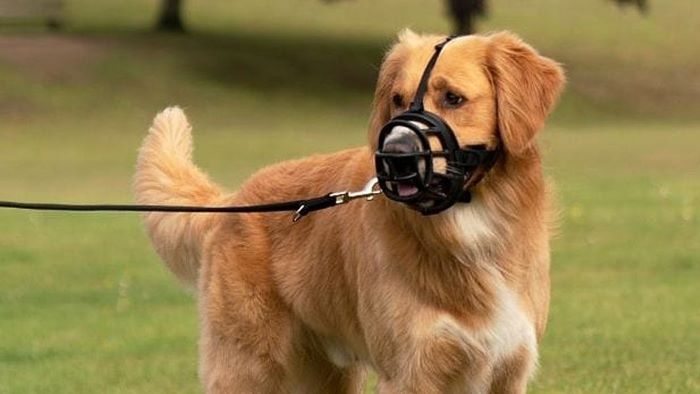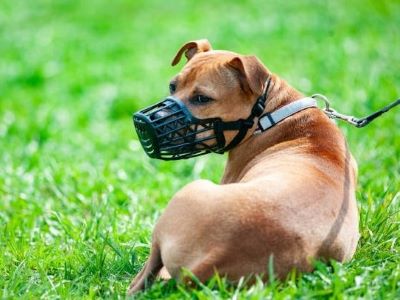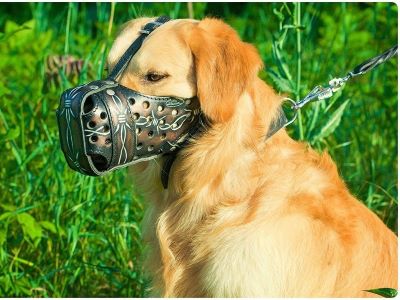A muzzle can be a useful tool for preventing biting, but it must fit your dog properly. Learn how to measure your dog for a muzzle and choose the right type for their needs.

Key Takeaways
- Measuring your dog for a muzzle requires taking the length and circumference of their snout, and sometimes the neck.
- A well-fitted muzzle should allow your dog to pant, drink, and breathe comfortably, but not be too loose or tight.
- Different types of muzzles have different advantages and disadvantages, depending on your dog’s breed, temperament, and situation.
- Introducing a muzzle to your dog should be done gradually and positively, with rewards and praise.
How to Measure a Dog for a Muzzle?
Properly measuring your dog for a muzzle is essential to ensure their safety and comfort while allowing them to engage in normal activities. A well-fitted muzzle prevents biting, but it should also allow panting, drinking, and normal breathing.
Let’s see the tools we need to measure the dog’s snout:
| Tools | Purpose |
|---|---|
| Soft Measuring Tape | Ensures accurate measurements without causing discomfort. |
| Pen and Paper📝 | For recording the measurements. |
| Treats | To keep your dog calm and cooperative.🍭 |
Find a quiet and comfortable space for the measurement. Engage in some play or cuddling to help your dog relax. Ensure your dog is in a calm state of mind, as anxiety can affect the accuracy of measurements.
“Offer treats and praise continuously throughout the measuring process to create a positive experience. Speak reassuringly in a soothing tone to keep the dog calm and comfortable. End with affection and rewards🍗”, suggests the expert at AKC
Types of Muzzles
When selecting a muzzle, it’s important to choose the best dog muzzle for your pup’s needs. Here are some of the most common types of dog muzzles[1]:
- Basket muzzles: Made of plastic or wire, allow dogs to pant, drink, and take treats while preventing biting. Less restrictive but can be chewed through.
- Fabric muzzles: Lightweight and adjustable. Allow panting and drinking but not treat access. Easier to put on but less durable.

- Short snout muzzles: Designed for brachycephalic breeds like bulldogs with shorter snouts. The open area around the nose.
- Soft silicone muzzles: Comfortable and pliable but durable. Good for small or nervous dogs. Allow panting.
- Wire cage muzzles: Mesh wire construction. Excellent control and visibility. Not great for nervous or long-term use.
Measuring the Dog
Let your dog sniff and investigate the measuring tape to familiarize them with the tool. Gently touch their snout with the tape to desensitize them to the sensation, which can help keep them calm during the process:
1. Length
Begin by locating the tip of your dog's nose. This is the starting point for measuring the muzzle length. Using your soft measuring tape, carefully extend it from the tip of the nose towards the eyes, stopping just before you reach the eyes.👀
Ensure that the tape is straight and that it follows the natural contours of your dog’s snout. Take note of the measurement you obtain; this is the muzzle length.
2. Circumference
Locate the widest part of your dog's snout, which is typically just below the eyes. This is where you will take the circumference measurement.📃 Gently wrap the measuring tape around the snout, making sure it fits snugly but is not overly tight.
It should be secure enough to prevent removal but not cause discomfort. Once you have wrapped the tape around the snout and confirmed the fit, record the measurement. This is the muzzle circumference.
3. Neck
In some cases, certain muzzle styles may require an additional measurement of the neck circumference.
To obtain this measurement, place the measuring tape around your dog's neck, just behind the ears.👂 Ensure that the tape is comfortably snug around the neck without being too tight.
Checking for Proper Fit
After you’ve carefully measured your dog’s snout and neck (if required), the next crucial step is to ensure that the chosen muzzle fits your dog correctly. Here’s how to do it:
- Compare measurements to sizing chart and select appropriate muzzle size. Size up if between sizes.
- Gently place muzzle over dog’s snout. Ensure they can open mouth slightly to pant and breathe. Check for space between end of muzzle and nose for panting.

- Ensure that the nosepiece of the muzzle does not push against your dog’s nostrils, allowing them to breathe freely.🐶
- Muzzle should fit snug but not too tight. Insert finger between strap and skin to check. Make minor adjustments to adjustable straps for proper fit.
- Ensure muzzle does not block eyes or press on them uncomfortably. Observe eyes and nose once muzzle is on. Make sure breathing and vision are unobstructed.
The goal is a secure fit that prevents biting but is not too restrictive. Proper fitting ensures your dog’s comfort and safety while wearing the muzzle. However, it’s important not to keep the muzzle on too long. Refer to our guide on “How long can a dog wear a muzzle?” for more tips.
Adjustments and Testing
After initially fitting the muzzle, it’s important to make any necessary adjustments and ensure that your dog is comfortable sharing it.
Ensure that the straps are securely fastened but not too tight. You should be able to slip one finger comfortably between the strap and your dog’s skin. If the muzzle has multiple adjustment points, make minor tweaks to achieve the perfect fit.
Initially, let your dog wear the muzzle for short durations indoors in a familiar and stress-free environment. While your dog is wearing the muzzle, closely monitor their behaviour and comfort.
Ensure that your dog can breathe comfortably through the muzzle and that there are no signs of distress. Watch for any signs of discomfort, such as pawing🐾 at the muzzle, excessive drooling, or attempts to remove it.
Reward them for calm behaviour and compliance, helping them understand that wearing the muzzle can be a positive experience.
FAQs
❓Is It Easy to Muzzle-Train a Dog?
Dogs can learn to enjoy wearing muzzles in the same way that they learn to wear a collar or harness. Take the time to introduce a muzzle in a positive and fun way, so your dog knows it’s nothing to worry about.
❓Do Vets Recommend Muzzles?
A muzzle often creates a quieter, more relaxed, and much safer environment for your dog, your vet, and yourself. From the vet’s point of view: A muzzle eliminates the risk of your vet suffering a physical injury due to a bite that could leave them unable to work for a few days or longer.
❓What Are the Benefits of a Muzzle?
Your dog may have a strong prey instinct and want to attack critters, or she may be reactive to dogs or strangers. In these cases, using a muzzle is a critical piece in any behaviour plan. Many dog groomers work with muzzles for this exact reason. It protects them and reduces the risk of a reactive bite or injury.
❓What Are the Two Types of Muzzle?
The first is a basket muzzle, which looks like a basket that goes over the dog’s mouth. This lets the dog pant and drink water, so they can wear it for longer. The second type is a soft muzzle. These are usually made from cloth or soft leather and wrap tightly around the dog’s mouth, keeping it closed.
Conclusion
A well-fitted muzzle prevents biting incidents and tragic outcomes while allowing dogs to continue natural activities like panting and drinking. Yet muzzles should not be used as Band-Aids for behavioural issues, responsible dog owners should also prioritize training.
With patience and care, most pups can overcome their troublesome ways without living life behind lines. Measure mindfully, train thoughtfully.🐶
So, will you take the lead in ensuring the safety, comfort, and responsible care of your loyal companion, let’s start with the simple but vital question: How can you measure your dog for a muzzle?
Know what dogs have to be muzzled in uk based on breed regulations in your area. This will help ensure you are complying with local laws.
Reference:
- Cpdt, S. G. M. (2023b). Dog muzzles: When, why, and how to correctly use them. American Kennel Club.



